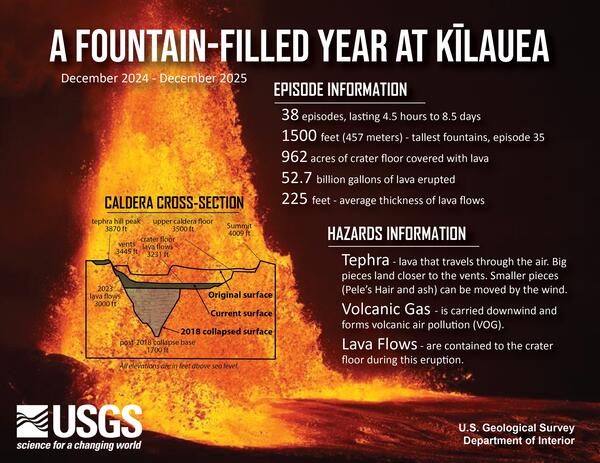It's been one year since a unique episodic lava fountaining eruption began at Kīlauea’s summit on December 23, 2024—a style of activity not seen in nearly 40 years! Over the past 12 months, Halemaʻumaʻu crater has hosted 38 eruptive episodes, each lasting from a few hours to more than a week, separated by quiet pauses.
Images
Hawaiian Volcano Observatory images of eruptive activity, field work, and more.
It's been one year since a unique episodic lava fountaining eruption began at Kīlauea’s summit on December 23, 2024—a style of activity not seen in nearly 40 years! Over the past 12 months, Halemaʻumaʻu crater has hosted 38 eruptive episodes, each lasting from a few hours to more than a week, separated by quiet pauses.
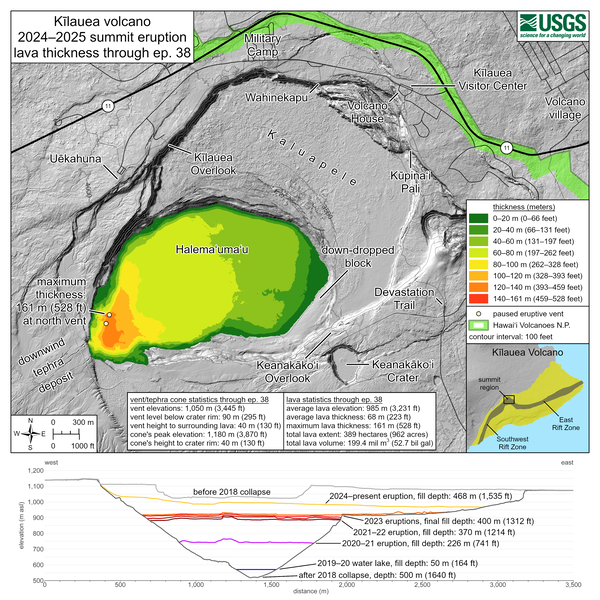
December 22, 2025—Kīlauea summit eruption lava thickness through episode 38
December 22, 2025—Kīlauea summit eruption lava thickness through episode 38This map shows thickness values for lava flows within Halema‘uma‘u crater from the Kīlauea summit eruption that began on December 23, 2024. These values were calculated by topographic differencing between a digital elevation model collected on December 9, 2025—after eruptive episode 38—and one from before the eruption began.
December 22, 2025—Kīlauea summit eruption lava thickness through episode 38
December 22, 2025—Kīlauea summit eruption lava thickness through episode 38This map shows thickness values for lava flows within Halema‘uma‘u crater from the Kīlauea summit eruption that began on December 23, 2024. These values were calculated by topographic differencing between a digital elevation model collected on December 9, 2025—after eruptive episode 38—and one from before the eruption began.

December 23, 2025 — Photo compilation for the 1-year anniversary of the ongoing eruption at the summit of Kīlauea
December 23, 2025 — Photo compilation for the 1-year anniversary of the ongoing eruption at the summit of KīlaueaPhoto compilation of the 38 lava fountaining episodes that occurred the first year of the ongoing eruption at the summit of Kīlauea. The eruption started on December 23, 2024, and the eruption continues: episode 39 is expected soon.
December 23, 2025 — Photo compilation for the 1-year anniversary of the ongoing eruption at the summit of Kīlauea
December 23, 2025 — Photo compilation for the 1-year anniversary of the ongoing eruption at the summit of KīlaueaPhoto compilation of the 38 lava fountaining episodes that occurred the first year of the ongoing eruption at the summit of Kīlauea. The eruption started on December 23, 2024, and the eruption continues: episode 39 is expected soon.
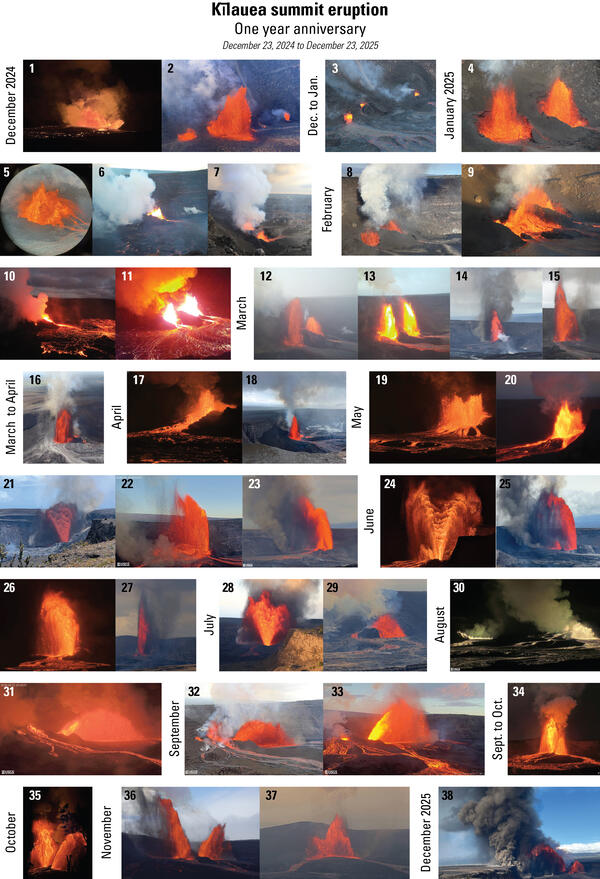
December 23, 2025 — Photo calendar compilation for the 1-year anniversary of the ongoing eruption at the summit of Kīlauea
December 23, 2025 — Photo calendar compilation for the 1-year anniversary of the ongoing eruption at the summit of KīlaueaPhoto calendar compilation of the 38 lava fountaining episodes that occurred the first year of the ongoing eruption at the summit of Kīlauea, with month time-stamps. The eruption started on December 23, 2024, and the eruption continues: episode 39 is expected soon.
December 23, 2025 — Photo calendar compilation for the 1-year anniversary of the ongoing eruption at the summit of Kīlauea
December 23, 2025 — Photo calendar compilation for the 1-year anniversary of the ongoing eruption at the summit of KīlaueaPhoto calendar compilation of the 38 lava fountaining episodes that occurred the first year of the ongoing eruption at the summit of Kīlauea, with month time-stamps. The eruption started on December 23, 2024, and the eruption continues: episode 39 is expected soon.
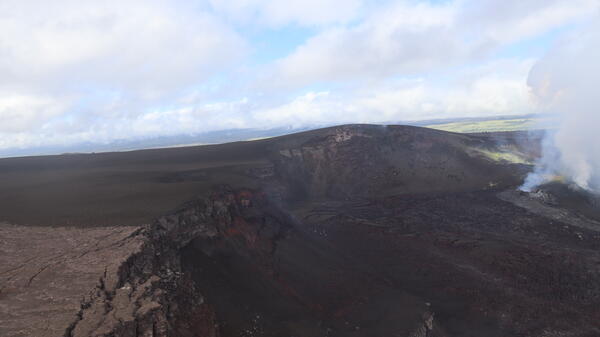
December 19, 2025 — Episode 38 tephra deposits along Kīlauea caldera rim
December 19, 2025 — Episode 38 tephra deposits along Kīlauea caldera rimDuring a monitoring helicopter overflight on December 19, 2025, USGS geologists captured this southwest looking photo of the tephra hill that has grown over the past year of episodic lava fountaining at the summit of Kīlauea.
December 19, 2025 — Episode 38 tephra deposits along Kīlauea caldera rim
December 19, 2025 — Episode 38 tephra deposits along Kīlauea caldera rimDuring a monitoring helicopter overflight on December 19, 2025, USGS geologists captured this southwest looking photo of the tephra hill that has grown over the past year of episodic lava fountaining at the summit of Kīlauea.
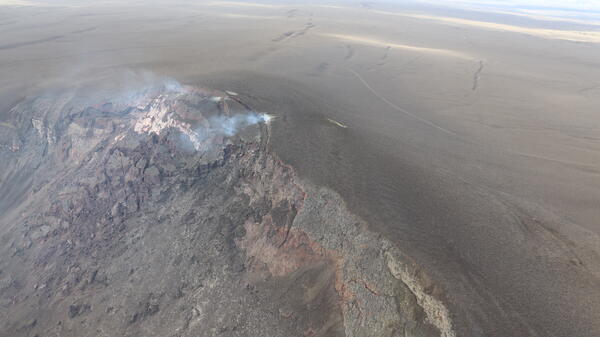
December 19, 2025 — Aerial view of Kīlauea tephra hill
December 19, 2025 — Aerial view of Kīlauea tephra hillAerial photo showing the tephra hill on the western margin of Kaluapele (Kīlauea caldera), which has grown over the past year of 38 lava fountaining episodes within Halema‘uma‘u. The arcuate scarps are from landslides of tephra that have fallen back into the caldera near the north and south vents that have erupted all the material making up the tephra hill.
December 19, 2025 — Aerial view of Kīlauea tephra hill
December 19, 2025 — Aerial view of Kīlauea tephra hillAerial photo showing the tephra hill on the western margin of Kaluapele (Kīlauea caldera), which has grown over the past year of 38 lava fountaining episodes within Halema‘uma‘u. The arcuate scarps are from landslides of tephra that have fallen back into the caldera near the north and south vents that have erupted all the material making up the tephra hill.
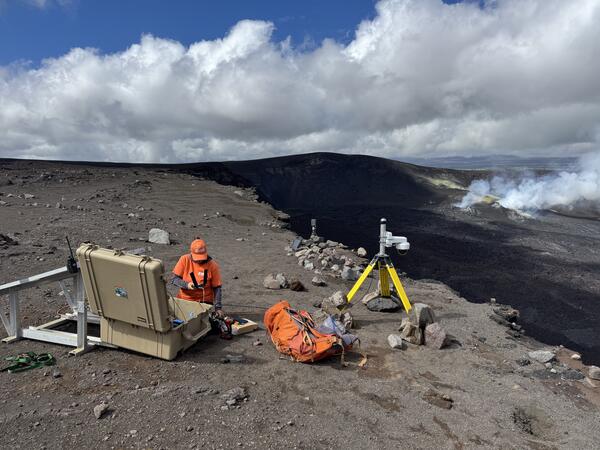
December 19, 2025 — New V3cam deployed at the summit of Kīlauea
December 19, 2025 — New V3cam deployed at the summit of KīlaueaUSGS staff deployed a new V3cam on the south rim of Halemaʻumaʻu crater at the summit of Kīlauea volcano, within Hawaiʻi Volcanoes National Park. The camera, a pan-tilt-zoom model, replaces the V3cam that was located to the west, which was destroyed during episode 38 lava fountaining on December 6, 2025. USGS photo by M. Patrick.
December 19, 2025 — New V3cam deployed at the summit of Kīlauea
December 19, 2025 — New V3cam deployed at the summit of KīlaueaUSGS staff deployed a new V3cam on the south rim of Halemaʻumaʻu crater at the summit of Kīlauea volcano, within Hawaiʻi Volcanoes National Park. The camera, a pan-tilt-zoom model, replaces the V3cam that was located to the west, which was destroyed during episode 38 lava fountaining on December 6, 2025. USGS photo by M. Patrick.
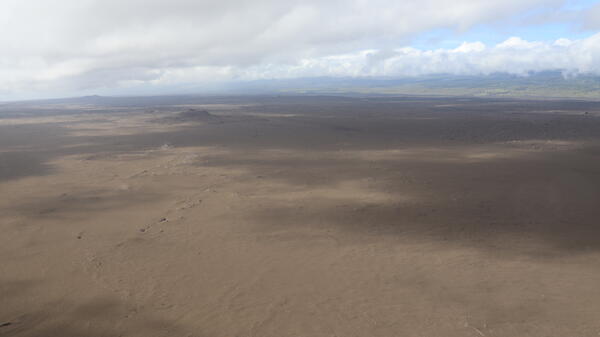
December 19, 2025 — Tephra covered landscape of the Southwest Rift Zone, Kīlauea
December 19, 2025 — Tephra covered landscape of the Southwest Rift Zone, KīlaueaThis aerial view, captured during a USGS Hawaiian Volcano Observatory monitoring overflight on December 19, 2025, shows the Southwest Rift Zone of Kīlauea between the summit caldera and the prominent scoria cones of Puʻukoaʻe.
December 19, 2025 — Tephra covered landscape of the Southwest Rift Zone, Kīlauea
December 19, 2025 — Tephra covered landscape of the Southwest Rift Zone, KīlaueaThis aerial view, captured during a USGS Hawaiian Volcano Observatory monitoring overflight on December 19, 2025, shows the Southwest Rift Zone of Kīlauea between the summit caldera and the prominent scoria cones of Puʻukoaʻe.
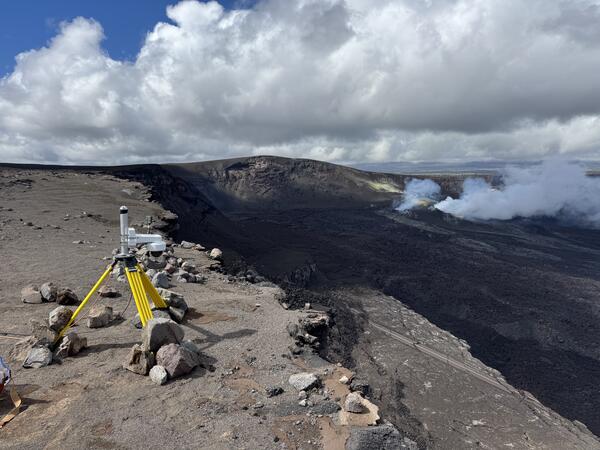
December 19, 2025 — V3cam at the summit of Kīlauea
December 19, 2025 — V3cam at the summit of KīlaueaV3cam on the south rim of Halemaʻumaʻu crater, Kīlauea volcano. USGS Hawaiian Volcano Observatory staff deployed the new camera on December 19, 2025, with permission from Hawaiʻi Volcanoes National Park. USGS photo by M. Patrick.
December 19, 2025 — V3cam at the summit of Kīlauea
December 19, 2025 — V3cam at the summit of KīlaueaV3cam on the south rim of Halemaʻumaʻu crater, Kīlauea volcano. USGS Hawaiian Volcano Observatory staff deployed the new camera on December 19, 2025, with permission from Hawaiʻi Volcanoes National Park. USGS photo by M. Patrick.
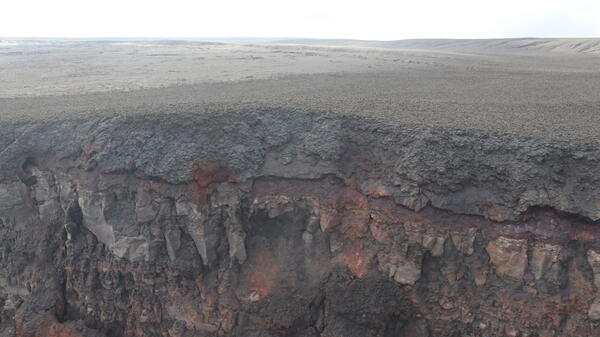
December 19, 2025 — Episode 38 spatter and tephra deposits along Kīlauea caldera rim
December 19, 2025 — Episode 38 spatter and tephra deposits along Kīlauea caldera rimAerial photograph looking at the southwestern rim of Kaluapele (Kīlauea caldera), where the original V3 livestream camera was located. This camera was buried under about 10 meters (32 feet) of molten spatter and tephra during inclined lava fountains of episode 38 on December 6, 2025. The upper third of the cliff face is this new spatter deposited during episode 38.
December 19, 2025 — Episode 38 spatter and tephra deposits along Kīlauea caldera rim
December 19, 2025 — Episode 38 spatter and tephra deposits along Kīlauea caldera rimAerial photograph looking at the southwestern rim of Kaluapele (Kīlauea caldera), where the original V3 livestream camera was located. This camera was buried under about 10 meters (32 feet) of molten spatter and tephra during inclined lava fountains of episode 38 on December 6, 2025. The upper third of the cliff face is this new spatter deposited during episode 38.
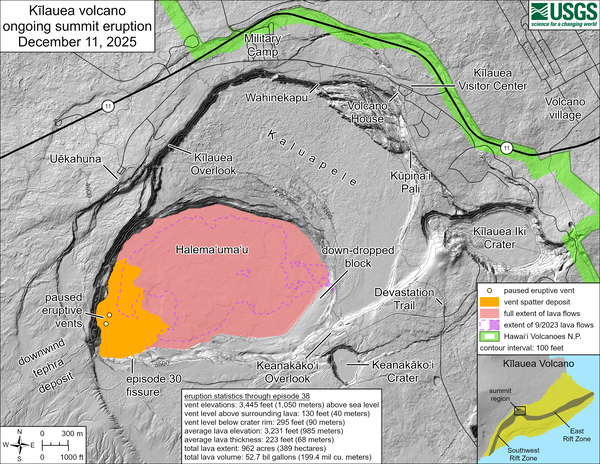
December 11, 2025—Kīlauea summit eruption reference map
December 11, 2025—Kīlauea summit eruption reference mapThis reference map depicts the Kīlauea summit eruption within Halema‘uma‘u crater that began on December 23, 2024. As of this posting on December 11, 2025, the eruption has had thirty-eight episodes, with the most recent occurring on December 6.
December 11, 2025—Kīlauea summit eruption reference map
December 11, 2025—Kīlauea summit eruption reference mapThis reference map depicts the Kīlauea summit eruption within Halema‘uma‘u crater that began on December 23, 2024. As of this posting on December 11, 2025, the eruption has had thirty-eight episodes, with the most recent occurring on December 6.
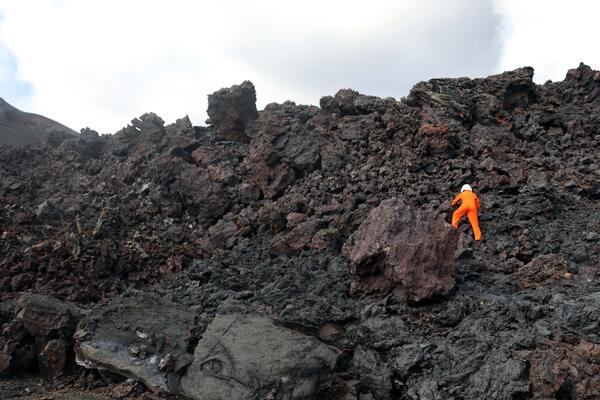
December 9, 2025 — Sampling episode 38 at the summit of Kīlauea
December 9, 2025 — Sampling episode 38 at the summit of KīlaueaA USGS Hawaiian Volcano Observatory geologist collects clinker from a rubbly spatter-fed lava flow in Halema‘uma‘u crater produced during episode 38 lava fountaining. These lava samples are collected with permission from Hawaiʻi Volcanoes National Park and analyzed in the lab to better understand the magmatic system of Kīlauea.
December 9, 2025 — Sampling episode 38 at the summit of Kīlauea
December 9, 2025 — Sampling episode 38 at the summit of KīlaueaA USGS Hawaiian Volcano Observatory geologist collects clinker from a rubbly spatter-fed lava flow in Halema‘uma‘u crater produced during episode 38 lava fountaining. These lava samples are collected with permission from Hawaiʻi Volcanoes National Park and analyzed in the lab to better understand the magmatic system of Kīlauea.
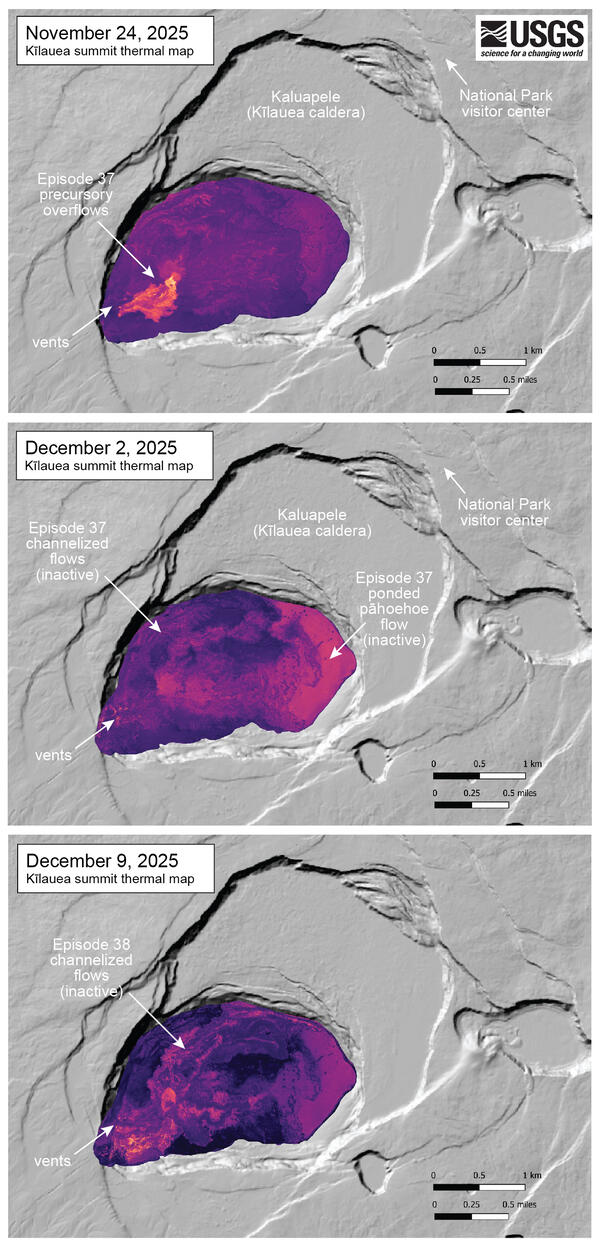
December 9, 2025 — Kīlauea summit thermal maps bracketing episodes 37 and 38
December 9, 2025 — Kīlauea summit thermal maps bracketing episodes 37 and 38These three thermal maps were made from oblique thermal images collected during helicopter overflights of Kīlauea summit. The collection dates bracket the last two episodes of lava fountaining - episode 37 was on November 25 and episode 38 was on December 6.
December 9, 2025 — Kīlauea summit thermal maps bracketing episodes 37 and 38
December 9, 2025 — Kīlauea summit thermal maps bracketing episodes 37 and 38These three thermal maps were made from oblique thermal images collected during helicopter overflights of Kīlauea summit. The collection dates bracket the last two episodes of lava fountaining - episode 37 was on November 25 and episode 38 was on December 6.

December 9, 2025 — Collecting GPS data from Kīlauea caldera floor
December 9, 2025 — Collecting GPS data from Kīlauea caldera floorA USGS Hawaiian Volcano Observatory scientist services a GPS station on the floor of Kaluapele (Kīlauea summit caldera). These instruments help measure ground deformation and track pressure changes in the summit magma reservoir. USGS photo by C. Sealing.
December 9, 2025 — Collecting GPS data from Kīlauea caldera floor
December 9, 2025 — Collecting GPS data from Kīlauea caldera floorA USGS Hawaiian Volcano Observatory scientist services a GPS station on the floor of Kaluapele (Kīlauea summit caldera). These instruments help measure ground deformation and track pressure changes in the summit magma reservoir. USGS photo by C. Sealing.
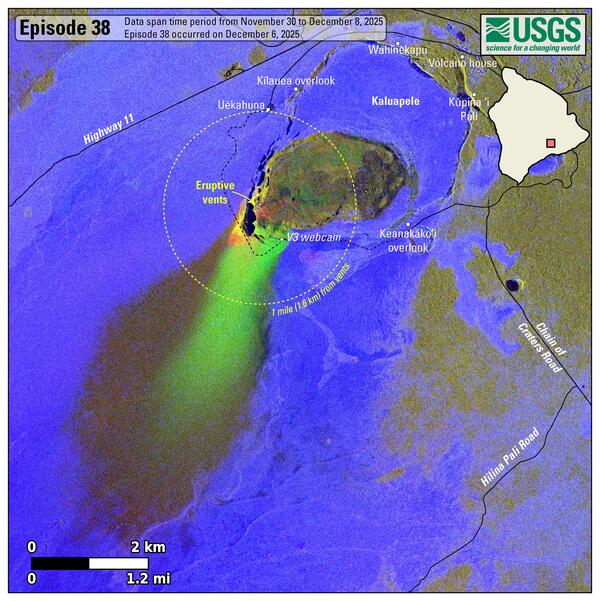
December 9, 2025 — Kīlauea lava flow and tephra fall map following episode 38
December 9, 2025 — Kīlauea lava flow and tephra fall map following episode 38This map shows lava flow and tephra accumulation at the summit of Kīlauea volcano associated with episode 38 of the ongoing eruption in Halemaʻumaʻu that started on December 23, 2024, using data recorded by the Italian Space Agency's (ASI) COSMO-SkyMed Second Generation satellite constellation.
December 9, 2025 — Kīlauea lava flow and tephra fall map following episode 38
December 9, 2025 — Kīlauea lava flow and tephra fall map following episode 38This map shows lava flow and tephra accumulation at the summit of Kīlauea volcano associated with episode 38 of the ongoing eruption in Halemaʻumaʻu that started on December 23, 2024, using data recorded by the Italian Space Agency's (ASI) COSMO-SkyMed Second Generation satellite constellation.
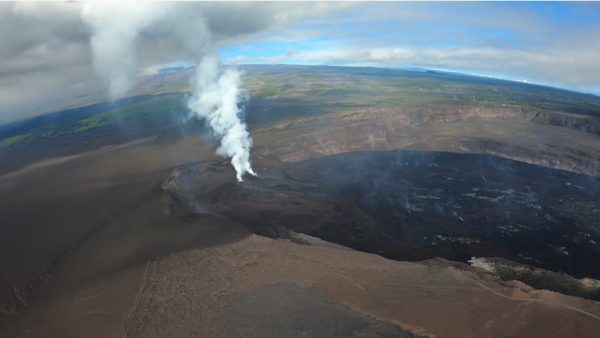
December 9, 2025—Aerial overview of Halemaʻumaʻu crater, Kīlauea volcano summit
December 9, 2025—Aerial overview of Halemaʻumaʻu crater, Kīlauea volcano summitOn December 9, USGS-Hawaiian Volcano Observatory geologists conducted an aerial overflight of Kīlauea summit region, following lava fountaining episode 38 of the Halemaʻumaʻu eruption on December 6. In this photo, the line on the ground in the lower left portion of the image shows the extent of tephra deposits created during episode 38.
December 9, 2025—Aerial overview of Halemaʻumaʻu crater, Kīlauea volcano summit
December 9, 2025—Aerial overview of Halemaʻumaʻu crater, Kīlauea volcano summitOn December 9, USGS-Hawaiian Volcano Observatory geologists conducted an aerial overflight of Kīlauea summit region, following lava fountaining episode 38 of the Halemaʻumaʻu eruption on December 6. In this photo, the line on the ground in the lower left portion of the image shows the extent of tephra deposits created during episode 38.
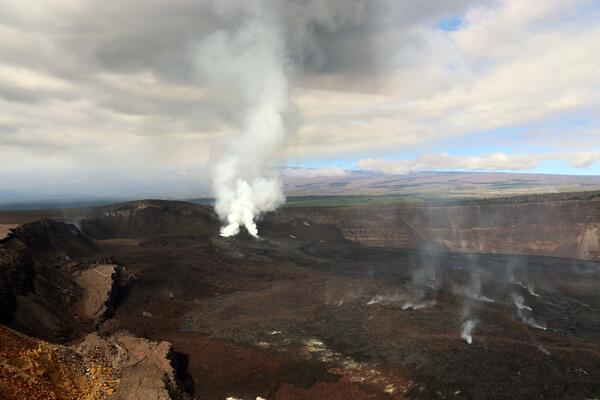
December 9, 2025 — Kīlauea summit overflight following episode 38 lava fountaining
December 9, 2025 — Kīlauea summit overflight following episode 38 lava fountainingOn Tuesday, December 9, USGS-Hawaiian Volcano Observatory geologists conducted a helicopter overflight of Kīlauea summit to survey changes from episode 38 lava fountaining a few days earlier. Scientists collected visual images for photogrammetry, thermal images, and collected lava samples from the caldera floor.
December 9, 2025 — Kīlauea summit overflight following episode 38 lava fountaining
December 9, 2025 — Kīlauea summit overflight following episode 38 lava fountainingOn Tuesday, December 9, USGS-Hawaiian Volcano Observatory geologists conducted a helicopter overflight of Kīlauea summit to survey changes from episode 38 lava fountaining a few days earlier. Scientists collected visual images for photogrammetry, thermal images, and collected lava samples from the caldera floor.
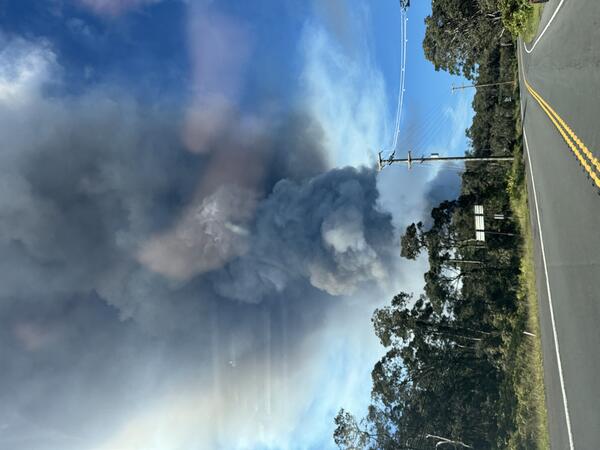
December 6, 2025—Halemaʻumaʻu eruption episode 38 plume
December 6, 2025—Halemaʻumaʻu eruption episode 38 plumeAn eruptive plume rises from the summit of Kīlauea volcano, visible from Highway 11 near Volcano Village on the Island of Hawaiʻi. This plume was generated during episode 38 of lava fountaining within Halemaʻumaʻu crater, which took place on December 6, 2025. USGS photo by K. Mulliken.
December 6, 2025—Halemaʻumaʻu eruption episode 38 plume
December 6, 2025—Halemaʻumaʻu eruption episode 38 plumeAn eruptive plume rises from the summit of Kīlauea volcano, visible from Highway 11 near Volcano Village on the Island of Hawaiʻi. This plume was generated during episode 38 of lava fountaining within Halemaʻumaʻu crater, which took place on December 6, 2025. USGS photo by K. Mulliken.
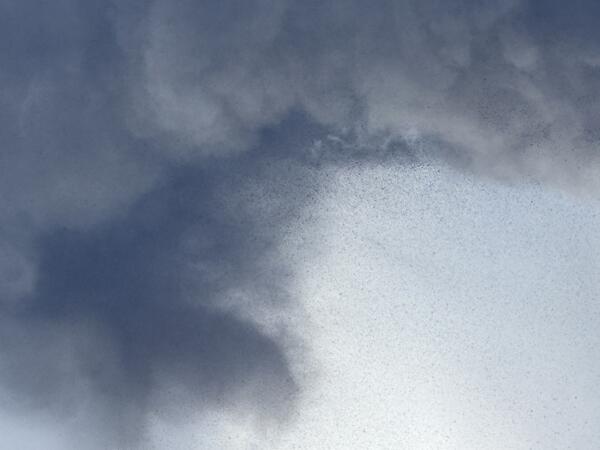
December 6, 2025—Tephra falls from the episode 38 eruptive plume in Halemaʻumaʻu
December 6, 2025—Tephra falls from the episode 38 eruptive plume in HalemaʻumaʻuThis telephoto view shows the darker-colored, cooler tephra particles erupted by the episode 38 lava fountains falling from the eruptive plume. USGS photo by K. Mulliken.
December 6, 2025—Tephra falls from the episode 38 eruptive plume in Halemaʻumaʻu
December 6, 2025—Tephra falls from the episode 38 eruptive plume in HalemaʻumaʻuThis telephoto view shows the darker-colored, cooler tephra particles erupted by the episode 38 lava fountains falling from the eruptive plume. USGS photo by K. Mulliken.
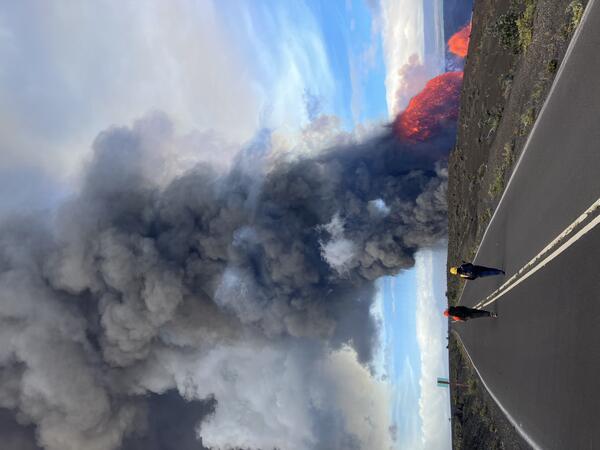
December 6, 2025—Monitoring eruption episode 38 in Halemaʻumaʻu crater
December 6, 2025—Monitoring eruption episode 38 in Halemaʻumaʻu craterIn the late morning of December 6, a crew of USGS Hawaiian Volcano Observatory scientists walked to the southern rim of Halemaʻumaʻu to watch Kīlauea summit eruption episode 38. Along the way they had dramatic views of the eruptive plume, which reached an altitude of over 20,000 feet (6,000 meters) above sea level during this episode. USGS photo by M.
December 6, 2025—Monitoring eruption episode 38 in Halemaʻumaʻu crater
December 6, 2025—Monitoring eruption episode 38 in Halemaʻumaʻu craterIn the late morning of December 6, a crew of USGS Hawaiian Volcano Observatory scientists walked to the southern rim of Halemaʻumaʻu to watch Kīlauea summit eruption episode 38. Along the way they had dramatic views of the eruptive plume, which reached an altitude of over 20,000 feet (6,000 meters) above sea level during this episode. USGS photo by M.
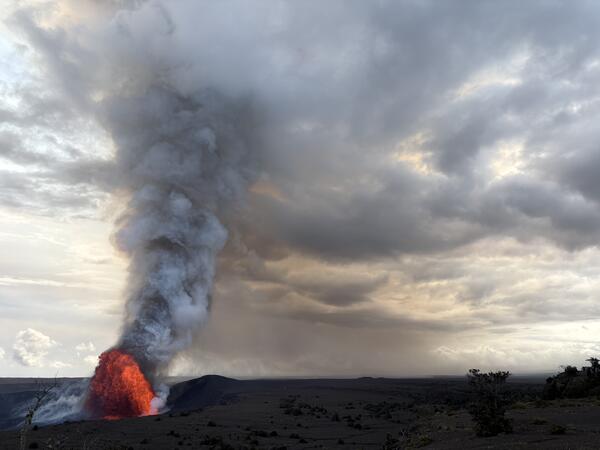
December 6, 2025—Episode 38 lava fountains and volcanic plume, Halemaʻumaʻu crater, Kīlauea summit
December 6, 2025—Episode 38 lava fountains and volcanic plume, Halemaʻumaʻu crater, Kīlauea summitThe volcanic landscape of Kīlauea volcano being reshaped during episode 38 of the eruption in Halemaʻumaʻu.
December 6, 2025—Episode 38 lava fountains and volcanic plume, Halemaʻumaʻu crater, Kīlauea summit
December 6, 2025—Episode 38 lava fountains and volcanic plume, Halemaʻumaʻu crater, Kīlauea summitThe volcanic landscape of Kīlauea volcano being reshaped during episode 38 of the eruption in Halemaʻumaʻu.


